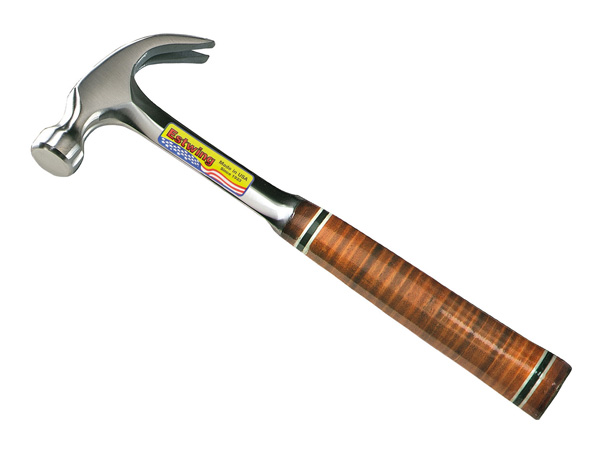
Start ‘em young. If you want to raise a self-reliant kid, get these tools into their hands.
1 Hammer
Age 7
Any rambunctious kid should be comfortable swinging a hammer. Just be sure it’s something light enough to handle correctly but sufficiently heavy to be effective. „No matter what the tool is, it has to fit,” Dahl says. „And that goes for anyone, whether male or female, young or old.” A claw hammer is essential for pulling the inevitable bent nails—and if your kid still struggles, predrill a few holes so he or she can figure out the correct technique.
2 Needle-Nose Pliers
Age 8
As soon as children master scissors, they’re ready for pliers, which have similar mechanics but are far more versatile. They’ll be happier using smaller, 6-inch models with comfy rubberized handles. Set them loose on a spool of 12-gauge insulated copper wire, and once they get the hang of using the tool with one hand, they’ll be bending, cutting, crimping, tightening, stripping, and twisting that wire into a variety of shapes while their classmates are still perfecting basic scrapbook skills.
3 Pocketknife
Age 9
A sharp knife and a fallen branch are all your kid needs to begin a lifetime of shaping wood. For now, stress the importance of cutting away from
the body while keeping the other hand safely behind the blade. With more experience, your child can experiment with pare (pull) cuts. Either way, he or she should be able to hold both the knife and the workpiece securely. A utility knife with a retractable blade has a large handle for a tight grip; it’ll also give a universal lesson in changing blades when the tool becomes dull.
4 Handsaw
Age 10
Avoiding workshop meltdowns means teaching children proper techniques
early on. The handsaw, for example, can discourage any budding woodworker if taught incorrectly. „The key is always minimizing frustration,” says Paul Steiner, who teaches construction at Woodbridge Senior High School in Virginia. „Set them up so they’re comfortable getting their body over the board.” Build a sawhorse that fits them—perhaps only 12 to 16 inches tall—and give them a razor-sharp 15-inch crosscut saw.
5 Ladder
Age 11
Climbing trees is for kids; tweens get there faster with a ladder. As with all tools, correct setup is critical for safe use. Have them place the ladder on a firm, level surface away from doors and windows. Ensure it extends at least 3 feet past the supporting branch and that it’s leaning at the correct angle. They can check this by standing at the base of the ladder and putting their arms straight out in front; their palms should touch the rung that’s at shoulder height.
6 Soldering Iron
Age 12
When you were 12, you built an AM radio inside a Tic Tac box. Your kid, however, lives in a world of Arduino-type microcontrollers that can operate robots. Don’t be intimidated, though. The essentials of electronics and the tools used to work with them haven’t changed much. So grab your trusty old pencil-tipped iron and a spool of rosin-core solder, go over a few basic skills—tinning stranded wire is a good start—and beam as your kid’s chess-playing robot dominates the next science fair.
7 Jigsaw
Age 14
No cutting tool is more versatile than a jigsaw. It produces curvy shapes in wood, plastics, and thin metals, making it ideal for kid-friendly projects such as, well, jigsaw puzzles. It also provides a valuable lesson in recognizing a power tool’s limits. As your child turns the jigsaw into a curve, he or she will feel the tension in the blade as it binds against the material. Too much and the blade will break.
8 Cordless Drill
Age 13
Your child’s first power tool is one of the safest and most versatile. „Kids need it no matter what they’re building, whether a birdhouse or a Pinewood Derby car,” Steiner says. To start, skip the drill bits—they’ll just get broken. Instead, clip the head off a finish nail and chuck it up; it takes more abuse, and it’s easier to replace. „A four-penny nail works as a 1/16-inch bit,” Steiner says. „You can work all the way up to a 16-penny nail, which is about a 1/8-inch.”
9 Circular Saw
Age 15
Are your children ready for a grown-up tool? That’s for you to decide. „Some kids are more comfortable with tools at age 7 than others are at 15,” Dahl says. „Be honest about their skill level; don’t force a tool on them that they’re not ready for.” Be honest about your own skill level too—and don’t let your ego stop you from asking an experienced friend or family member for a quick class.
10 Chain Saw
Age 16
Young woodcutters need at least a year’s apprenticeship to learn the safe handling of a chain saw. „It’s not where the saw starts that counts; it’s where it finishes the cut,” PM senior home editor Roy Berendsohn says. Even if you’re an experienced woodsman, consider taking a refresher class with an arborist so you don’t pass on bad habits to your kids. These often include skimping on safety gear such as chaps, boots, gloves, safety glasses, and hearing protection.
Sursa: popularmechanics.com
![]()














Leave a Reply